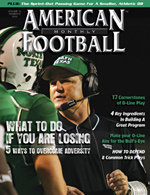AMERICAN FOOTBALL MONTHLY THE #1 RESOURCE FOR FOOTBALL COACHES
|
|
Article Categories
|
Setting the Tempo by Attacking and Reacting© More from this issueBy Kevin Cristillo, Defensive Line Coach
Kentucky Christian University
†
†† My philosophy as a D-line coach is to be aggressive and stop the run.† As a defensive lineman, your main job is to stop the run.† By stopping the run you are dictating the tempo of how the game is going to be played.† Almost every team wants to establish a run game presence so that they can complement that with their passing game.† Stopping a teamís ability to run puts them in a situation where they have to throw the ball.† This makes play calling easier for a defensive coordinator by taking the guessing game out of it.
††† Every defensive lineman wants to get as many sacks as possible. You can do this by putting the offense in more passing situations.† That is done by playing good defense on first and second dow....The full article can only be seen by subscribers.
Subscribe today!

|
|
|
NOT A SUBSCRIBER?
Subscribe
now to start receiving our monthly magazine PLUS get INSTANT
unlimited access to over 4000 pages of 100 percent football coaching
information, ONLY available at AmericanFootballMonthly.com!
|
|
|
HOME
|
MAGAZINE
|
SUBSCRIBE
|
ONLINE COLUMNISTS
|
COACHING VIDEOS
|
Copyright 2025, AmericanFootballMonthly.com
All Rights Reserved






